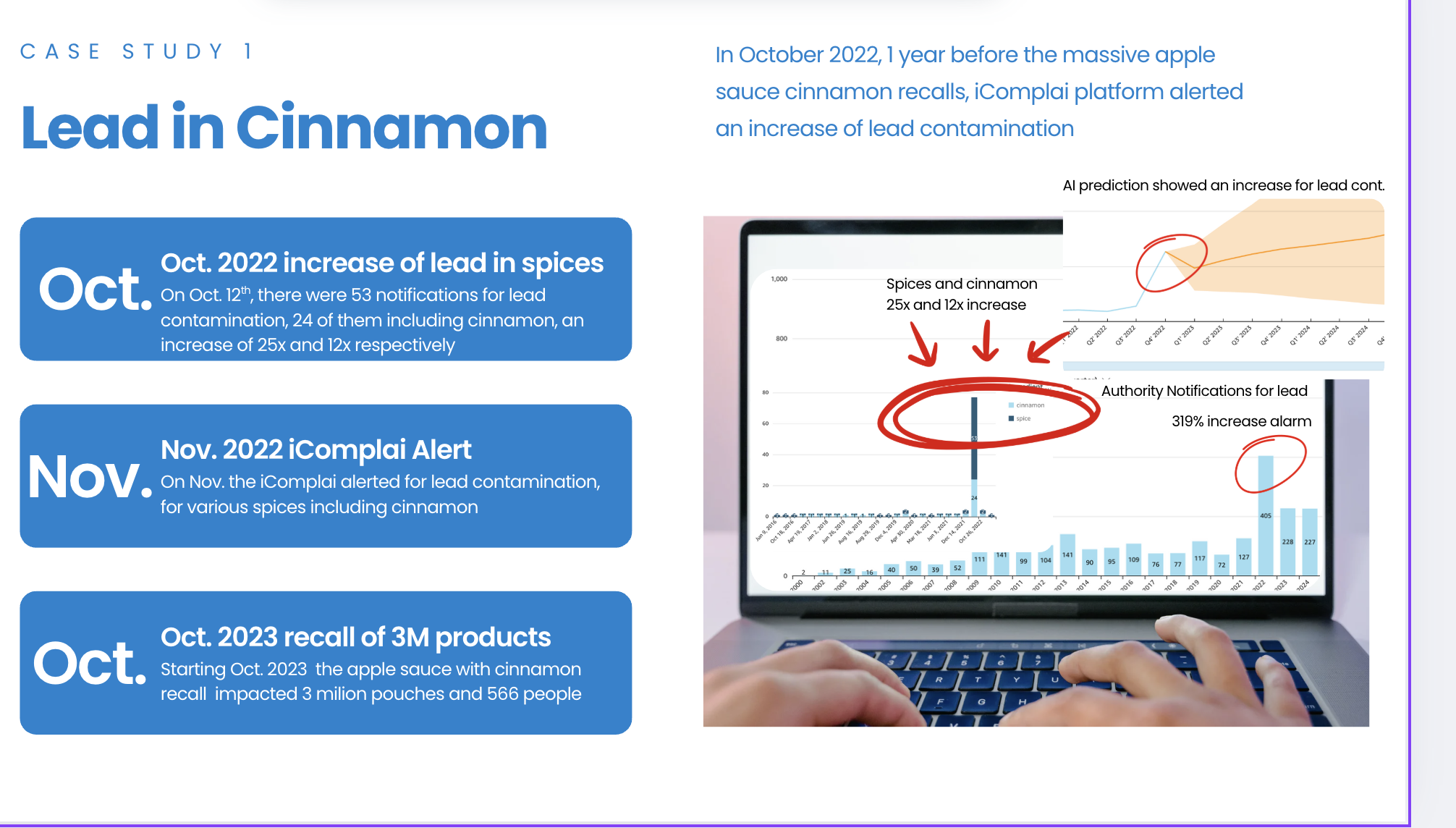iComplai alerts one year before the massive FDA apple sauce cinnamon recalls
1. Executive Summary
In October 2022, one year before the massive U.S. applesauce-cinnamon recall, the iComplai AI platform detected an abnormal rise in lead contamination signals in spices, with cinnamon emerging as a high-risk ingredient.
By correlating international food safety notifications, historical contamination trends, and predictive analytics, iComplai identified a pattern that later materialized as the 2023–2024 recall impacting 3 million pouches and 566 affected individuals (CDC, 2024).
2. Background
Raw Material: Cinnamon (Cinnamomum verum / C. cassia)
Risk Category: Heavy metals (lead and chromium)
Global Context: Cinnamon is widely sourced from Southeast Asia and Latin America. While natural lead residues can occur through soil uptake, such extreme contamination levels (as later found in 2023) point toward intentional adulteration with lead chromate used for color enhancement.
3. Early Warning Signals: October 2022
On 12 October 2022, iComplai detected a sharp global increase in lead contamination alerts for spices.
Data:
53 total notifications for lead contamination
24 of these involved cinnamon
Represented a 25× rise in spice-related alerts and a 12× rise for cinnamon compared to baseline years
This event coincided with a broader 319 % increase in global lead-related notifications, visible in iComplai’s aggregated food hazard trend chart (see “Authority Notifications for Lead 319% increase alarm”).
4. Predictive Model Insights
The iComplai AI model flagged the pattern as statistically abnormal. Using multivariate inputs—historical recall data, RASFF patterns, and external trade and regulatory information—it generated a predictive risk curve showing a likely continuation of lead contamination events into 2023.
The model projected:
Sustained increase of lead contamination alerts (upper bound approaching 900 notifications)
Cinnamon classified under “High-Likelihood / High-Impact” raw materials for Q1–Q3 2023
5. iComplai Alert to Customers: November 2022
In November 2022, iComplai issued an internal alert for “Lead Contamination in Spices,” specifically naming cinnamon as an ingredient of concern.
Customers using the iComplai platform were advised to:
Intensify supplier verification on lead and heavy metal certificates.
Conduct targeted lab testing for incoming cinnamon shipments.
Map suppliers in Southeast Asia for potential environmental or adulteration risks.
6. Event Validation: October 2023 Recall
In October 2023, approximately one year after iComplai’s prediction, the U.S. FDA and CDC confirmed a major recall of cinnamon-containing applesauce pouches (e.g., WanaBana, Schnucks, Weis).
Impact:
3 million pouches recalled
566 probable and confirmed child lead poisoning cases across 44 U.S. states (CDC, 2024)
Contamination traced to a cinnamon processor in Ecuador (Negasmart / Carlos Aguilera)
Measured lead levels: up to 5.8 ppm, indicating intentional adulteration.
(External sources: CDC MMWR April 2024, FDA Recall Summary)
7. Outcome and Verification
iComplai’s predictive alert preceded official regulatory action by ~11 months.
Customers who monitored the risk early could:
Adjust procurement sources
Increase frequency of heavy-metal testing
Avoid exposure to contaminated lots
The incident validated iComplai’s predictive analytics framework for heavy-metal hazard forecasting.
8. Lessons Learned
Early surges in cross-ingredient contamination patterns (e.g., multiple spices) are strong precursors of specific ingredient crises.
Adulteration Recognition: Extreme contamination spikes (orders of magnitude above baseline) signal intentional adulteration — a different profile than natural environmental contamination.
Predictive Power: Continuous AI monitoring can detect such anomalies far earlier than periodic regulatory sampling.
Supply Chain Transparency: The lack of full traceability in spice sourcing chains enables contamination risks; digital risk mapping is essential.
9. Conclusion
This case demonstrates that AI-based predictive analytics can anticipate emerging hazards before they become global food safety crises.
By identifying the lead in cinnamon signal nearly a year before the U.S. recall, iComplai showcased how proactive intelligence empowers food manufacturers and buyers to act ahead of regulatory alerts, minimizing public health risk and reputational damage.

